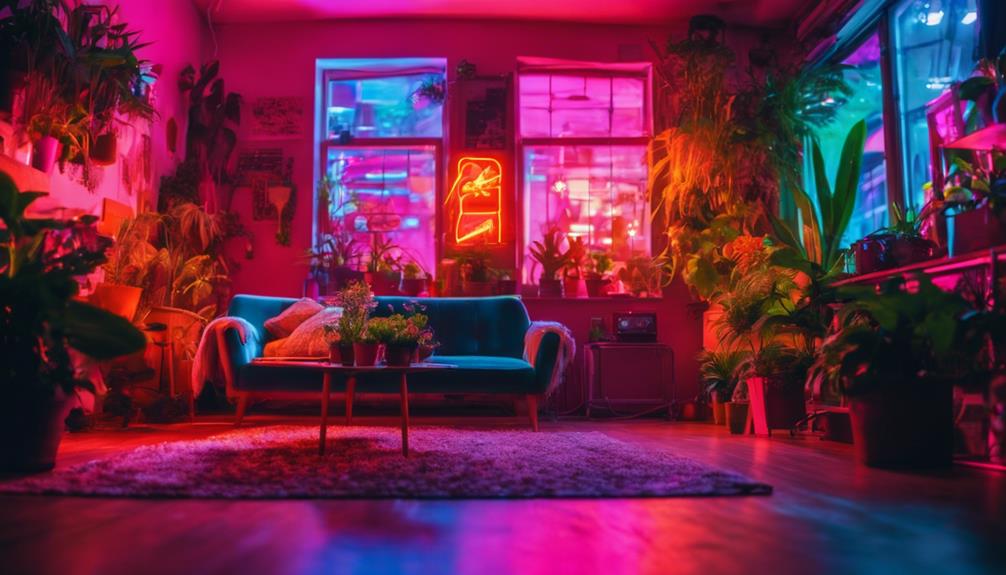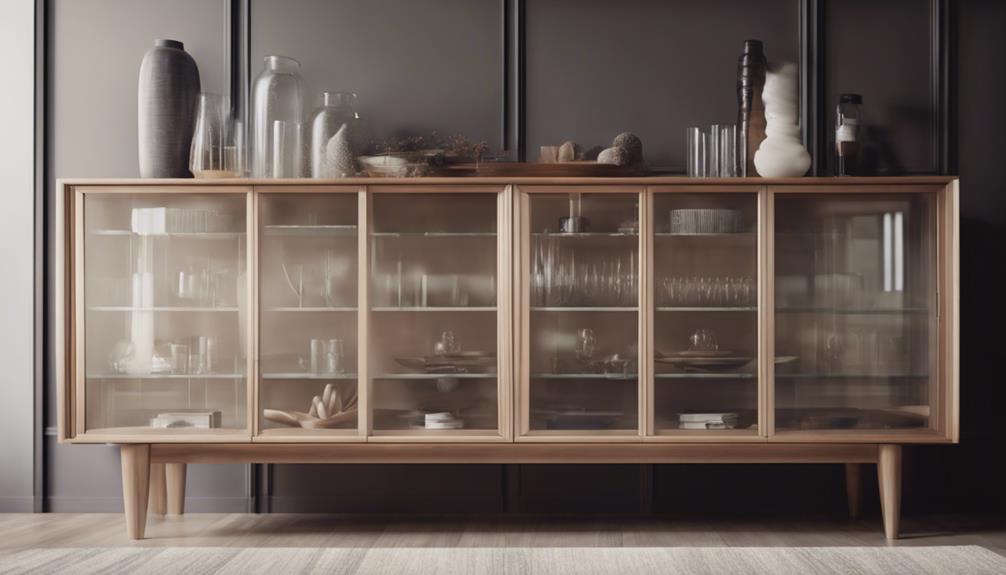Aesthetic neon lights can totally transform your space, bringing it to life with vibrant colors like pink, blue, and green. You can customize their designs and brightness to perfectly match your vibe. Whether you hang a neon quote or position a funky cactus sculpture, these lights serve as eye-catching decor that wows anyone who walks in. Plus, they're energy-efficient and built to last over 100,000 hours. Easy to install with USB compatibility, they fit almost anywhere. Keep exploring to discover more ideas on how to brighten up your space with these stunning illuminations!
Key Elements
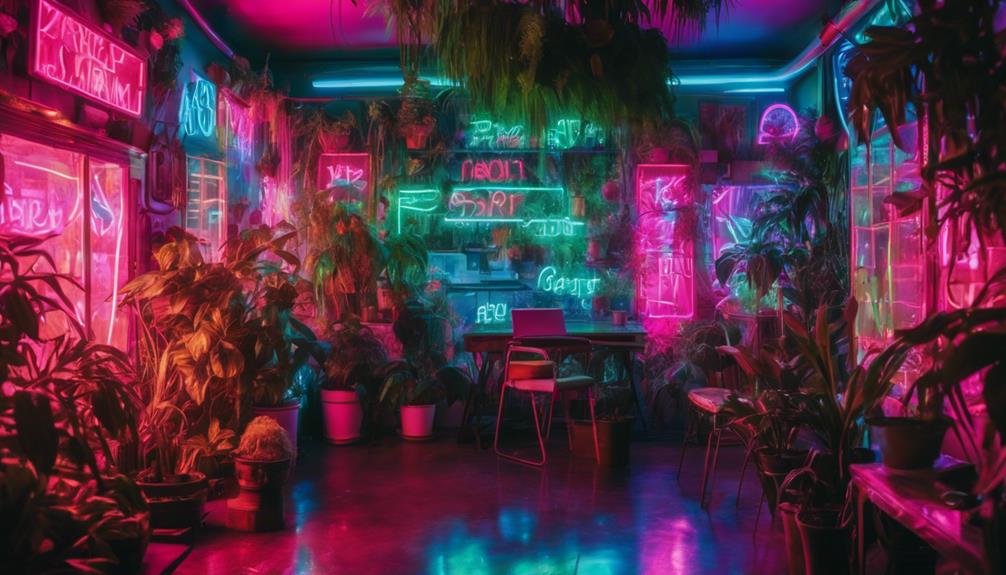
When you think about aesthetic neon lights, the color scheme, materials, and textures play an essential role in their appeal.
These elements not only define the overall look but also influence how they fit into your space.
Let's explore how each of these key components contributes to the allure of neon signage.
Color Scheme
Aesthetic neon lights burst with vibrant colors like pink, blue, and green, instantly transforming any space into a lively and inviting atmosphere. These neon lights aren't just about brightness; they offer incredible customization options that allow you to choose specific colors and designs to match your decor or personal taste.
Whether you're aiming for a playful vibe or an elegant touch, you can find the perfect neon sign that complements your style.
Furthermore, the flexible brightness settings of neon signs let you adjust the illumination from 10% to 100%. This feature allows you to create the ideal ambiance for any occasion, whether it's a cozy night in or a lively gathering with friends. By simply dimming or brightening the lights, you can shift the mood to suit your needs effortlessly.
With various sizes and fonts available, these neon lights can be tailored to express your unique personality. From home decor to business branding, the versatility of neon lights makes them a fantastic addition to any space.
Materials
Neon lights are crafted from eco-friendly LED technology, ensuring both energy efficiency and durability. Unlike traditional glass neon tubes, these modern neon signs use shatter-resistant PVC tubes and robust acrylic backing. This combination provides a lightweight yet sturdy design, making them perfect for various settings, whether it's your bedroom, living room, or office.
One of the standout features of LED neon signs is their adjustable brightness settings. You can easily customize the ambiance from as low as 10% to a full 100%, giving you control over the mood of your space. Additionally, these signs boast an impressive lifespan, exceeding 100,000 hours, which means you won't have to worry about replacing them anytime soon.
Installation is a breeze since they're powered by USB connections, allowing you to plug them into any USB outlet without hassle. The materials used in these signs not only contribute to their aesthetic appeal but also enhance their functionality.
Textures
The vibrant colors and sleek designs of neon lights create a unique texture that enhances the overall aesthetic of any space. When you hang a neon sign like the 'Babe You Look So Cool,' it instantly transforms your wall decor, adding a modern touch that captivates attention. The smooth glow of these light up signs contrasts beautifully with various surfaces, making them a focal point in any room.
The adjustable brightness levels allow you to customize the ambiance, giving your space a dynamic feel. You can set the neon sign to a soft glow for a cozy atmosphere or crank it up to full brightness for a lively party vibe. The lightweight construction makes installation a breeze—simply mount it on your wall with nails or hooks.
Moreover, the eco-friendly LED materials used in these signs guarantee durability and a lifespan of over 100,000 hours. This means you can enjoy their striking aesthetic without worrying about frequent replacements. As you integrate these textures into your space, you'll create an inviting environment that wows everyone who walks through the door.
Essential Fixtures and Furniture
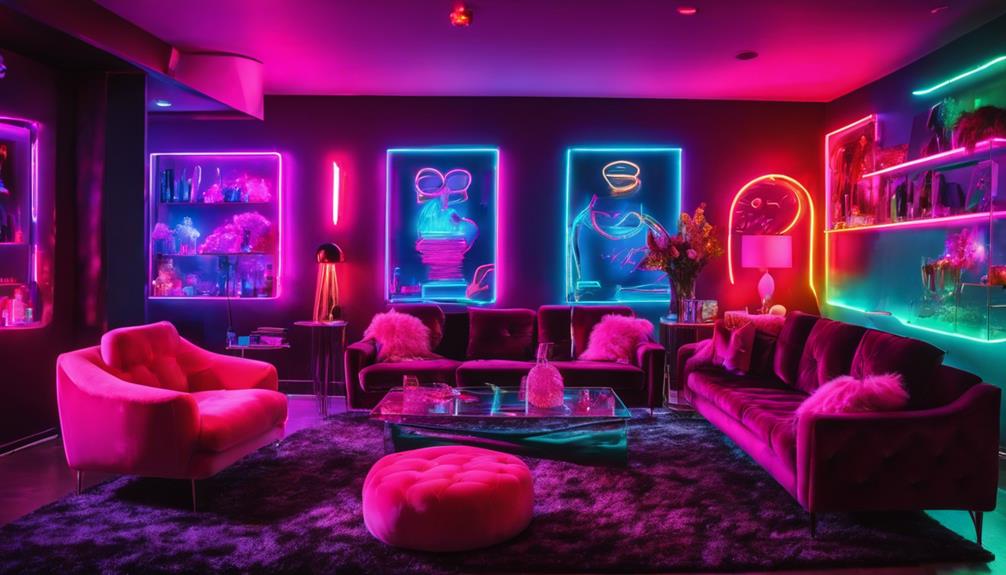
When you're looking to enhance your space, consider essential fixtures like a vintage neon bar sign or custom neon wall art.
These pieces not only brighten up a room but also add personality and style.
Plus, a custom neon quote sign can serve as a daily inspiration while making your decor truly unique.
Vintage Neon Bar Sign
Vintage bar signs add a nostalgic charm and vibrant energy to your space, making them essential fixtures for any entertainment venue. Vintage neon bar signs not only enhance your decor but also create a lively ambiance that attracts customers. With their enchanting glow, these signs can considerably increase foot traffic, drawing in patrons who are enthusiastic for an inviting atmosphere.
Crafted with durable materials, many of these signs utilize energy-efficient LED technology, ensuring they last longer while consuming less power. Plus, you can find a wide variety of designs and colors, allowing you to customize the signs to reflect specific logos, slogans, or artistic elements that resonate with your bar's theme.
Adjustable brightness settings on vintage neon signs provide flexibility, letting you set the mood for different times of the day or special events. Whether you want a bright, festive vibe or a cozy, relaxed setting, these signs can adapt to your needs. Incorporating a vintage neon bar sign into your venue not only serves as a functional piece but also as a striking focal point that elevates your space's overall appeal.
Custom Neon Wall Art
Custom neon wall art serves as a vibrant addition to any space, allowing you to express your unique style and personality. With custom neon signs, you can tailor the size, color, and font to perfectly match your decor. Whether you're brightening up a bedroom, game room, or creative space, these pieces can transform any environment into something extraordinary.
LED neon options offer an energy-efficient way to enhance ambiance, with adjustable brightness ranging from 10% to 100%. This means you can set the mood just right for any occasion. The enchanting designs and vibrant colors of custom neon wall art not only grab attention but also add a fun element to your space.
Constructed from durable PVC tubes and sturdy acrylic backing, these neon signs promise long-lasting performance and safety. Plus, installation is a breeze! You typically only need a USB power source and pre-drilled holes for mounting, so you can easily incorporate this unique design into your decor without hassle.
Custom Neon Quote Sign
How can a custom neon quote sign elevate your space while showcasing your personality and style? These eye-catching fixtures are perfect for expressing your thoughts, beliefs, or favorite phrases in a vibrant way. You can tailor your sign's size, color, and font to match your decor, ensuring it feels like a natural part of your environment.
With adjustable brightness settings ranging from 10% to 100%, you can easily create the desired ambiance for any occasion—whether it's a cozy night in or a lively gathering with friends. Made from durable PVC tubes with sturdy acrylic backing, these custom neon quote signs are designed for long-lasting use and are resistant to breakage, so you won't have to worry about wear and tear.
Installation is a breeze, as most signs come with a USB power cord and pre-drilled holes for easy wall mounting. Plus, their versatility as unique decor pieces means you can repurpose them for different events, making them a fantastic addition to any room.
Transform your space and let your personality shine with a custom neon quote sign!
Lighting Ideas
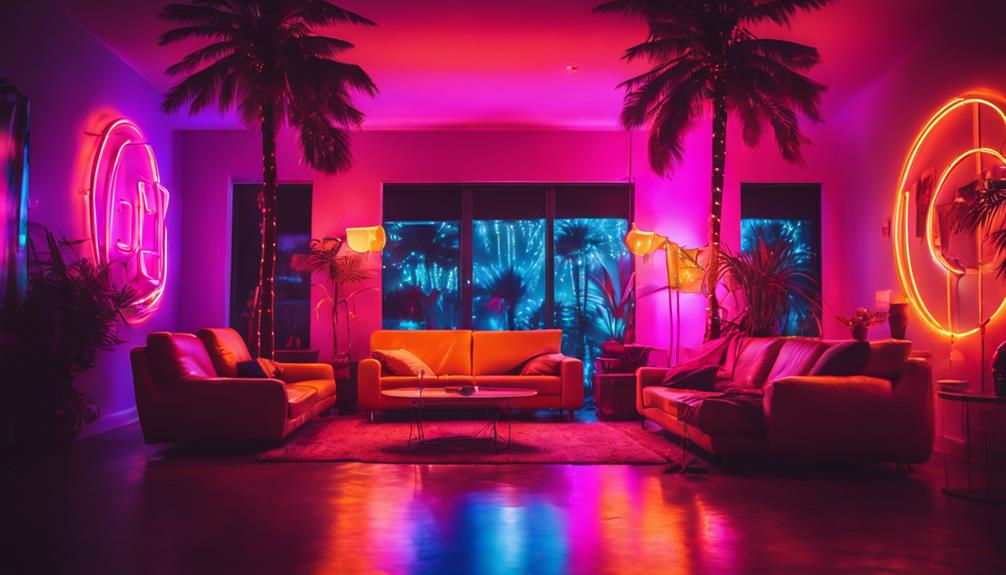
When it comes to lighting ideas, you can transform your space with neon strip lights, pendant fixtures, and wall sconces.
Each option offers a unique way to highlight your style while creating the right mood.
Let's explore some techniques to make your neon lighting truly stand out.
Neon Strip Lights Installation
Installing neon strip lights is straightforward, thanks to pre-drilled holes that simplify mounting in any space you choose. Whether you want to enhance your bedroom or create a lively atmosphere in your living room, these neon lights provide a perfect solution. The installation process typically involves using command strips, nails, or hooks, with the latter offering a more secure attachment.
You'll love the versatility of these lights, as they usually connect to a USB power source, allowing you to plug them into any USB outlet. This flexibility means you can set them up almost anywhere! Plus, with adjustable brightness settings ranging from 10% to 100%, you can easily customize the ambiance to match your mood or occasion.
Another great aspect is their longevity; with an average lifespan exceeding 100,000 hours, these neon strip lights are a durable choice for decorative lighting.
Neon Pendant Light Fixtures
Neon pendant light fixtures bring a bold and vibrant touch to your space, making them perfect for enhancing kitchens, dining areas, or any room where you want to make a statement. With their striking colors and unique designs, these lights create an inviting atmosphere that instantly grabs attention.
One of the standout features of neon pendant lights is their use of energy-efficient LED technology. Not only do these LED lights provide long-lasting illumination—often exceeding 100,000 hours—they also consume minimal power, making them an eco-friendly choice. You'll enjoy bright, stunning light without the hefty energy bill.
Customization options are another great aspect of neon pendant fixtures. You can choose specific sizes, colors, and designs that best suit your decor style, ensuring your lighting complements your space perfectly. Plus, many models come with adjustable brightness settings, allowing you to switch from a soft glow to full brightness, depending on the mood you want to create.
Installation is generally straightforward, thanks to easy-to-follow mounting instructions. With neon pendant lights, you're not just adding illumination; you're enhancing the overall aesthetic of your home.
Neon Wall Sconce Arrangement
Transforming your space with neon wall sconces can create a stunning visual impact, adding both style and personality to any room. These vibrant fixtures, like the Babe You Look So Cool sign, enhance your decor with their enchanting designs and colors. You can easily install them using pre-drilled holes and a USB cord, making setup a breeze.
One of the best features of neon wall sconces is their adjustable brightness, allowing for a customized ambiance that caters to different moods and settings. Whether you want a soft glow for a relaxing evening or bright light for a lively gathering, these sconces adapt effortlessly to your needs.
Positioning your sconces strategically can turn them into eye-catching focal points. Consider placing them above a stylish bar cart, beside a cozy reading nook, or as part of a gallery wall. Their unique designs, such as music lyrics or artistic shapes, draw attention and elevate the overall aesthetic of your space.
With their durable, energy-efficient LED technology, neon wall sconces promise long-lasting beauty, making them a smart addition to your home decor.
Neon Accent Lighting Techniques
Exploring various neon accent lighting techniques can elevate your space, turning ordinary areas into vibrant highlights that reflect your personal style. One effective way to do this is by strategically placing neon signs, like the trendy 'Babe You Look So Cool' sign, to create focal points in your room. This not only adds a splash of color but also infuses energy into your decor.
Consider using neon signs with adjustable brightness, such as the “Planet Earth Classroom Neon Sign,” which allows you to customize the ambiance from 10% to 100%. This flexibility makes it perfect for any occasion, whether you're hosting lively gatherings or enjoying a quiet evening at home.
Neon lights come in creative shapes and quotes, making them especially popular in spaces like bedrooms and tattoo parlors. Plus, they're energy-efficient and durable, boasting a lifespan of over 100,000 hours. This longevity guarantees they're a cost-effective lighting solution that can seamlessly fit into various themes and occasions, from colorful birthday parties to chic home decor.
With these techniques, you can truly enhance the aesthetic appeal of your space!
Decorative Elements

When you're looking to add a playful touch to your decor, consider decorative elements like a neon cactus sculpture or a neon flamingo figure.
These vibrant accents not only brighten up your space but also reflect your unique style.
A neon pineapple accent piece can further enhance the tropical vibe, making your room feel lively and inviting.
Neon Cactus Sculpture
Adding a neon cactus sculpture to your space instantly injects a vibrant and trendy flair, making it a standout decorative element. These eye-catching pieces serve as perfect conversation starters in homes, offices, or themed events. Crafted with eco-friendly LED technology, neon cactus sculptures not only provide a striking visual impact but also guarantee energy efficiency and durability.
You'll find a variety of colors and styles that can seamlessly complement your aesthetic, whether you lean towards contemporary or eclectic decor. The lightweight design allows for easy installation and repositioning, giving you the flexibility to change your decor on a whim.
One of the best features of neon cactus sculptures is their adjustable brightness settings. This means you can create a customized ambiance that suits any occasion, whether you're hosting a lively gathering or enjoying a casual evening at home.
Neon Flamingo Figure
Just like the neon cactus sculpture, the Neon Flamingo Figure brings a lively burst of color and charm to your space, making it an ideal choice for those looking to elevate their decor with a tropical vibe. This vibrant decorative element is perfect for enhancing preppy and girly aesthetics, instantly transforming any room. Crafted with eco-friendly LED technology, it provides energy-efficient illumination while radiating a stunning pink glow that's hard to miss.
Weighing only around 1.34 pounds, it's lightweight and versatile, allowing you to easily mount it on walls or place it on shelves. The adjustable brightness feature lets you customize the ambiance, helping you create the perfect atmosphere for any occasion—whether it's a relaxed evening or a lively party. Measuring approximately 14.33 x 12.32 x 0.98 inches, the Neon Flamingo Figure stands out as an eye-catching focal point in bedrooms, bars, or any gathering space.
Integrating this piece into your neon collection not only brightens your decor but also showcases your unique style. Illuminate your space with this playful flamingo and watch as it captivates everyone who enters!
Neon Pineapple Accent Piece
Bringing a splash of tropical charm, the Neon Pineapple Accent Piece instantly brightens up any room with its vibrant glow and playful design. This eye-catching decor item measures approximately 14 inches in height, making it perfect for shelves or desktops. Whether you're decorating for a summer-themed room or adding a beach-inspired vibe, this neon light fits seamlessly into any setting.
Crafted with eco-friendly LED technology, the Neon Pineapple consumes minimal energy while delivering bright illumination, ensuring you can enjoy its beauty sustainably. You'll appreciate the adjustable brightness settings, allowing you to customize the ambiance from a soft glow to a bold statement piece.
Ideal for bedrooms, living rooms, or party settings, this decorative element not only enhances your decor but also serves as a fun conversation starter. Guests will love its unique design, and you'll find that it elevates the overall vibe of your space.
Flooring
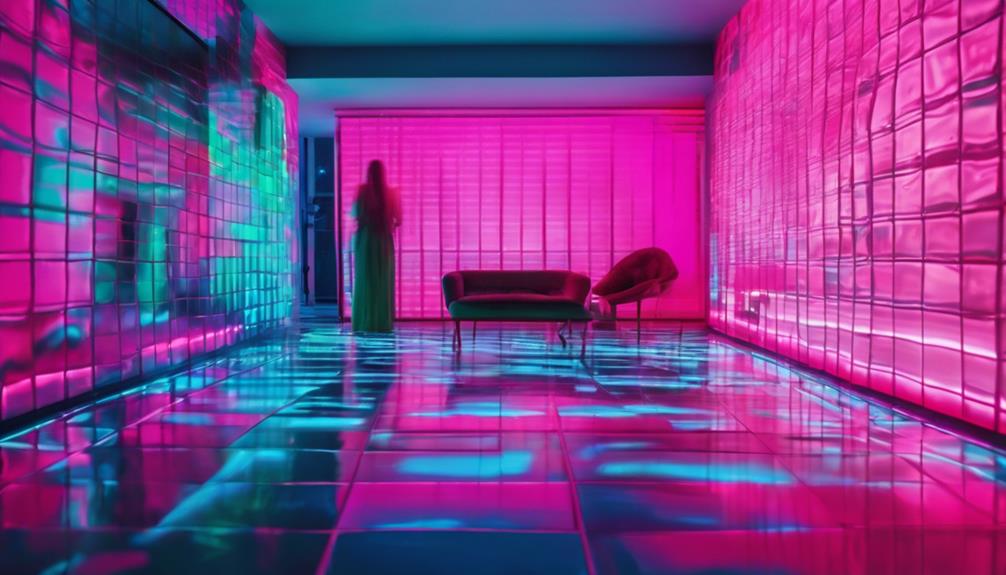
When you think about flooring, consider how it can elevate your neon aesthetic.
Retro checkerboard tile, glow-in-the-dark vinyl, and neon-infused epoxy finishes all offer unique ways to enhance your space.
Each option not only adds visual interest but also complements the vibrant energy of neon lights.
Retro Checkerboard Tile Design
Retro checkerboard tile design offers a striking black and white pattern that effortlessly enhances any space, whether you're aiming for a vintage vibe or a modern look. This classic aesthetic isn't just visually appealing; it's also practical. The tiles are durable and can withstand heavy foot traffic, making them perfect for high-traffic areas like kitchens, dining rooms, and entryways.
One of the great things about retro checkerboard tiles is that they're easy to clean, allowing you to maintain that fresh appearance with minimal effort. Available in various materials such as ceramic, vinyl, and laminate, you can find the perfect fit for your style and budget.
The geometric pattern of these tiles does wonders for small spaces, creating a sense of depth and interest that draws the eye.
Plus, if you're feeling adventurous, you can tackle the installation as a DIY project. Many peel-and-stick varieties make transforming your floors quick and straightforward.
With retro checkerboard tile design, you can effortlessly elevate your space and enjoy both style and functionality.
Glow-In-The-Dark Vinyl Flooring
Glow-in-the-dark vinyl flooring transforms any space by providing a unique illumination that not only enhances its aesthetic appeal but also adds a touch of magic for nighttime use. This innovative flooring option features phosphorescent materials that absorb light during the day, emitting a soft glow at night. You can choose from various styles and colors, allowing you to create striking designs that suit your personal taste and complement your existing decor.
Durability is a key benefit, as this flooring is water-resistant and easy to clean, making it perfect for high-traffic areas like kitchens, bathrooms, and playrooms. The glow effect lasts for several hours once the lights are off, creating an enchanting ambiance for nighttime gatherings or children's rooms, ensuring a fun and inviting atmosphere.
Installation is straightforward, whether you opt for glue or a peel-and-stick method, making it accessible for DIY enthusiasts. By incorporating glow-in-the-dark vinyl flooring into your home, you'll not only elevate your space's aesthetic but also enjoy a practical solution that stands out during the day and shines at night.
Illuminate your home with this stylish and functional flooring choice!
Neon-Infused Epoxy Floor Finish
Neon-infused epoxy floor finishes deliver a vibrant burst of color that instantly transforms any space into a visually enchanting environment. By incorporating neon pigments, these floors create a striking visual appeal that can enhance both residential and commercial areas. You'll appreciate the customizable nature of these finishes, as you can choose from a wide range of colors and designs to match your desired theme.
The application process involves a multi-layered system, ensuring durability and longevity while providing a bright, glowing surface that withstands heavy foot traffic. Plus, these finishes resist chemicals, stains, and moisture, making them easy to maintain—perfect for high-traffic areas like showrooms and event venues.
While installation typically requires professional expertise and curing time can vary based on environmental conditions, the end result is a unique, eye-catching flooring solution that truly stands out. Imagine walking on a floor that not only looks amazing but also holds up well against everyday wear and tear.
With neon-infused epoxy flooring, you'll not only elevate the aesthetic of your space but also enjoy a functional and durable surface that wows everyone who steps inside.
Conclusion
Incorporating aesthetic neon lights into your space transforms it into a vibrant haven.
You'll not only brighten up your surroundings but also create an inviting atmosphere that wows everyone who steps in.
By mixing essential fixtures, creative lighting ideas, and unique decorative elements, you can craft a personalized style that reflects your personality.
So, go ahead and light up your life—your space deserves it, and you'll love the energy it brings!
